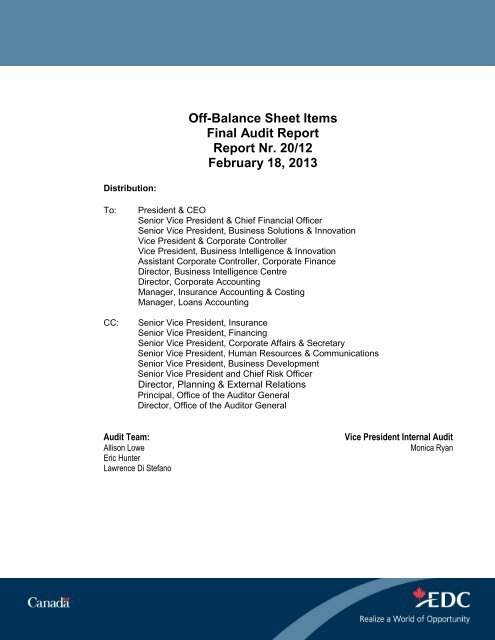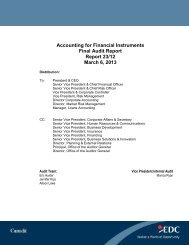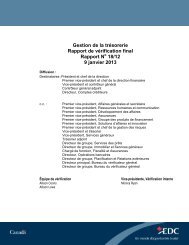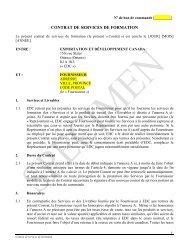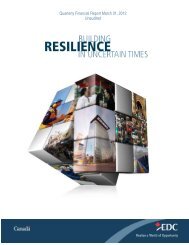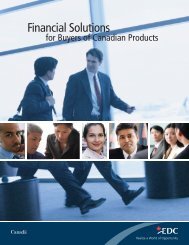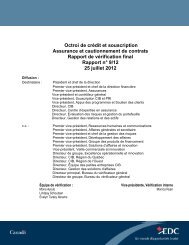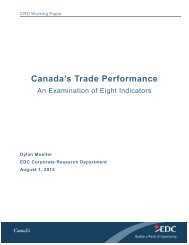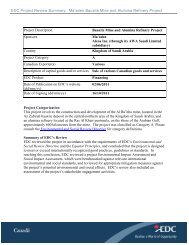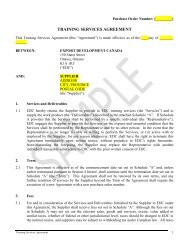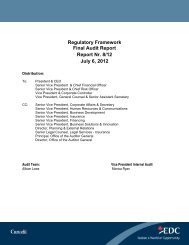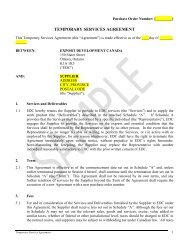Off-Balance Sheet Items - Final Audit Report - February 18 ... - EDC
Off-Balance Sheet Items - Final Audit Report - February 18 ... - EDC
Off-Balance Sheet Items - Final Audit Report - February 18 ... - EDC
Create successful ePaper yourself
Turn your PDF publications into a flip-book with our unique Google optimized e-Paper software.
<strong>Off</strong>-<strong>Balance</strong> <strong>Sheet</strong> <strong>Items</strong><strong>Final</strong> <strong>Audit</strong> <strong>Report</strong><strong>Report</strong> Nr. 20/12<strong>February</strong> <strong>18</strong>, 2013Distribution:To:CC:President & CEOSenior Vice President & Chief Financial <strong>Off</strong>icerSenior Vice President, Business Solutions & InnovationVice President & Corporate ControllerVice President, Business Intelligence & InnovationAssistant Corporate Controller, Corporate FinanceDirector, Business Intelligence CentreDirector, Corporate AccountingManager, Insurance Accounting & CostingManager, Loans AccountingSenior Vice President, InsuranceSenior Vice President, FinancingSenior Vice President, Corporate Affairs & SecretarySenior Vice President, Human Resources & CommunicationsSenior Vice President, Business DevelopmentSenior Vice President and Chief Risk <strong>Off</strong>icerDirector, Planning & External RelationsPrincipal, <strong>Off</strong>ice of the <strong>Audit</strong>or GeneralDirector, <strong>Off</strong>ice of the <strong>Audit</strong>or General<strong>Audit</strong> Team:Allison LoweEric HunterLawrence Di StefanoVice President Internal <strong>Audit</strong>Monica Ryan
Table of ContentsIntroduction ........................................................................................................... 3<strong>Audit</strong> Objectives & Scope ..................................................................................... 3Internal <strong>Audit</strong> Opinion ........................................................................................... 3<strong>Audit</strong> Findings & Recommendations ................................................................... 4Conclusion ............................................................................................................ 6<strong>Off</strong>-<strong>Balance</strong> <strong>Sheet</strong> <strong>Items</strong> | <strong>February</strong> <strong>18</strong>, 2013 2
IntroductionIn accordance with our FY2012 <strong>Audit</strong> Plan, <strong>EDC</strong> Internal <strong>Audit</strong> performed an audit of the processessurrounding the financial reporting of the following <strong>Off</strong>-<strong>Balance</strong> <strong>Sheet</strong> items: contingent liabilities,financing commitments and special purpose entities. Contingent liabilities were CAD 28,959 million,financing commitments were CAD 12,333 million and special purpose entities had asset values of CAD6,520 million and a maximum exposure to loss of CAD 4,199 million at the end of December 2011.<strong>Audit</strong> Objectives & ScopeThe overall objective of this audit was to evaluate both the design and operating effectiveness of thetransaction and monitoring controls surrounding the financial reporting processes for <strong>Off</strong>-<strong>Balance</strong> <strong>Sheet</strong>items. The scope of this audit included the controls in place surrounding the identification anddetermination of amounts related to:Contingent liabilities with the exception of ARI single buyer insurance and selective cover whichwere excluded for materiality reasons;Financing commitments with the exception of commitments related to <strong>EDC</strong>’s Investmenttransactions which were included in the scope of the 2012 Investments <strong>Audit</strong>; andSpecial Purpose Entities (SPEs).The detailed fieldwork was performed from September through November 2012.Internal <strong>Audit</strong> OpinionIn our opinion, Opportunities Exist to Improve Controls 1 surrounding the disclosure of contingentliabilities amounts associated with insurance products and amounts relating to special purpose entities(SPEs) not controlled by <strong>EDC</strong>. We found that certain product features were either not known or theirimpact had not been reviewed from the perspective of accounting disclosure requirements. For example,exposure reserved for a fee by policyholders for future availability is not always treated as a contingentliability. We also found configuration issues with respect to reports used to determine contingent liabilityamounts. <strong>Final</strong>ly, the criteria for determining which transactions with SPEs are included in notedisclosures have not been recently reviewed by senior management. A number of issues were addressedduring the audit and additional action plans are in the process of being implemented.1Our standard audit opinions are as follows:- Strong Controls: Key controls are effectively designed and operating as intended. Best in class internal controls exist. Objectives of theaudited process are most likely to be achieved.- Well Controlled: Key controls are effectively designed and operating as intended. Objectives of the audited process are likely to beachieved.- Opportunities Exist to Improve Controls: One or more key controls do not exist, are not designed properly or are not operating asintended. Objectives of the process may not be achieved. The financial and/or reputation impact to the audited process is more thaninconsequential. Timely action is required.- Not Controlled: Multiple key controls do not exist, are not designed properly or are not operating as intended. Objectives of the process areunlikely to be achieved. The financial and/or reputation impact to the audited process is material. Action must follow immediately.<strong>Off</strong>-<strong>Balance</strong> <strong>Sheet</strong> <strong>Items</strong> | <strong>February</strong> <strong>18</strong>, 2013 3
<strong>Audit</strong> Findings & Recommendations1. Determination of Contingent Liability AmountsDuring the audit we found that the impact of certain product features on contingent liability amounts haseither not been identified or considered recently. For example, some PRI policies allow policyholders toautomatically reinstate the current policy liability upon payment of an eligible claim. The aggregate valueof these “auto-reinstatements” is included in determining the PRI portion of the insurance claimsallowance liability, but is not currently included in the amount reported as contingent liabilities.We also found that similar product features are not always treated consistently when determiningcontingent liability amounts. For example, under the terms and conditions of certain products such asTrade Finance Obligations (TFO), and Political Risk Insurance (PRI), policyholders can “reserve” creditcapacity for future use by the payment of a fee. This reservation of credit capacity is known as acommitment period for TFO and a standby period for PRI. Credit capacity reserved as part of acommitment period under TFO is reported as a contingent liability. However, credit capacity held duringa standby period is not reported as a contingent liability but is included when determining the InsuranceClaims Allowance.We have recommended that guidelines be developed for determining and calculating contingent liabilityamounts. In addition, a process should be implemented to review the calculation at each quarter end toensure compliance with guidelines. We also recommend that Insurance Accounting meet with theInsurance Group on an annual basis to ensure any changes to products, features, or underwriting practiceshave not impacted contingent liabilities amounts.Rating of <strong>Audit</strong> Finding – Major 2Action Owner – Manager, Insurance Accounting & CostingDue Date – Q2-20132. Completeness & Accuracy of Data Used to Compile Note DisclosuresThe MTIP Outstanding <strong>Report</strong> is used as the basis for reporting contingent liability amounts associatedwith the PRI and CIB products. However, we noted that the current liability amounts included on thisreport do not always match the amounts recorded in the underwriting system (MBC). The discrepanciesappear to be a result of report configuration issues. For example, in some cases the co-insurance ratio is2The ratings of our audit findings are as follows:− Major: a key control does not exist, is poorly designed or is not operating as intended and the financial and/or reputation risk ismore than inconsequential. The process objective to which the control relates is unlikely to be achieved. Corrective action isneeded to ensure controls are cost effective and/or process objectives are achieved.− Moderate: a key control does not exist, is poorly designed or is not operating as intended and the financial and/or reputationrisk to the process is more than inconsequential. However, a compensating control exists. Corrective action is needed to avoidsole reliance on compensating controls and/or ensure controls are cost effective.− Minor: a weakness in the design and/or operation of a non-key process control. Ability to achieve process objectives is unlikelyto be impacted. Corrective action is suggested to ensure controls are cost effective.<strong>Off</strong>-<strong>Balance</strong> <strong>Sheet</strong> <strong>Items</strong> | <strong>February</strong> <strong>18</strong>, 2013 4
eing applied twice resulting in an understatement of the contingent liability. In other cases, the currentliability is duplicated resulting in an overstatement of contingent liability.The Globex Estimated Actual Exposure <strong>Report</strong> is used as the basis for determining and reporting thecontingent liability associated with the ARI product. The configuration of this report includes businessrules for determining an estimate of contingent liability that were created in 2004. Some of the businessrules do not appear to align well with the current profile of the ARI program. For example, the reportalways applies a pre-shipment length of 30 days when calculating how long exposure is “on the books”for <strong>EDC</strong>. However, in reality the pre-shipment length can vary significantly.The process for determining and reporting financing commitment (undisbursed) amounts relatedspecifically to letters of offer is manually intensive and involves the use of separate credit exposurereports from both the ACBS and MBC systems. As a result, we found errors that were not identified inthe review and reporting process. For example, Letter of <strong>Off</strong>er amounts included in financingcommitments can sometimes include both original amounts that have already been disbursed andundisbursed renewal amounts.We have recommended that a detailed review be performed of the configuration of both the MTIPOutstanding <strong>Report</strong> and the Globex Estimated Actual Exposure <strong>Report</strong> to ensure amounts included inthese reports are accurate. In addition, we have recommended that the Business Intelligence Centre (BIC)group perform a comprehensive review of the ACBS and MBC credit exposure reports to detect alltransactions that are not letters of offers and treat appropriately. Secondly, we recommend the BIC grouprevisit their manual review and reporting process and consider process improvements to mitigate the riskof errors occurring.Rating of <strong>Audit</strong> Finding – MajorAction Owners – Manager, Insurance Accounting & Costing and Director, Business Intelligence CentreDue Date – Q3-20133. Special Purpose Entities (SPEs)<strong>EDC</strong>’s annual financial statements include a note on SPEs that states information regarding the nature oftransactions entered into by <strong>EDC</strong> that give rise to the SPEs, their comparative asset values and <strong>EDC</strong>’smaximum exposure to loss as a result of involvement with these SPEs.Information included in this note is derived from a questionnaire completed by Financing group financingmanagers for each transaction. We reviewed the design and completion of the questionnaire and noted thefollowing: Financing managers do not always have a clear understanding of the significance of thequestions; We were unable to determine the basis for certain questions - for example the importance ofdifferentiating between SPEs where <strong>EDC</strong> had a certain ownership or financing percentage; and It is not apparent why <strong>EDC</strong>’s participation in SPEs through Structured & Project Financetransactions is excluded.<strong>Off</strong>-<strong>Balance</strong> <strong>Sheet</strong> <strong>Items</strong> | <strong>February</strong> <strong>18</strong>, 2013 5
The SPE note includes information on SPEs that were not created by <strong>EDC</strong> and whose activities are notcontrolled/influenced by <strong>EDC</strong>. The obligation to report on these SPEs is unclear.We have recommended that the Manager, Loans Accounting perform a review of the IFRS accountingstandards that pertain to SPE treatment and implement a standardized financial reporting process that willensure <strong>EDC</strong> reporting is in compliance.Rating of <strong>Audit</strong> Finding – MajorAction Owner – Manager, Loans AccountingDue Date – Q2-2013ConclusionThe audit findings and recommendations have been communicated to and agreed by management, whohas developed action plans that are scheduled for implementation no later than Q3 2013.We would like to thank management for their support throughout the audit.<strong>Off</strong>-<strong>Balance</strong> <strong>Sheet</strong> <strong>Items</strong> | <strong>February</strong> <strong>18</strong>, 2013 6


